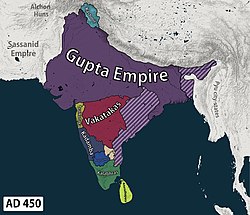Traikutaka dynasty
Traikutaka dynasty | |||||||||||
|---|---|---|---|---|---|---|---|---|---|---|---|
| c. 388 CE–c. 456 CE | |||||||||||
 Map of the territory of the Traikutakas (in yellow), along with their contemporaries, especially the Kadambas, the Vakatakas and the Gupta Empire. | |||||||||||
| Common languages | Sanskrit Prakrit | ||||||||||
| Religion | Hinduism | ||||||||||
| History | |||||||||||
• Established | c. 388 CE | ||||||||||
• Disestablished | c. 456 CE | ||||||||||
| |||||||||||
The Traikutaka dynasty were Abhira Kings who ruled Traikutaka kingdom from 388 to 456. Their name comes from the words for a three-peaked mountain ("Tri-kuta"). Kalidasa's Raghuvamsa mentions them, placing them in northern Konkan. The Traikutakas' territory extended to Aparanta and northern Maharashtra.[2] The Traikuṭakas who were a branch of the Abhira kings of the Puranas. They rose to power about 250 A. D. about the time of the middle Kshatrapas and after the decline of the Kshatrapas which began in 300 A. D. The disruption of their empire was probably the work of The Traikutakas who were their old neighbours and foes. Under the name of Haihayas the Traikuṭakas rose to supremacy about A. D. 455-6 established a branch at the city of Trikuta (most probably modern Junnar in the Poona district) and ruled over the Bombay Dakhan and South Gujarat during the period between 410 A.D.[3][4][5]
References[change | change source]
- ↑ Rapson, E. J. (Edward James) (1908). Catalogue of the coins of the Andhra dynasty, the Western Ksatrapas, the Traikutaka dynasty, and the "Bodhi" dynasty. London : Printed by order of the Trustees. p. 198.
- ↑ Rapson p.clxxxv.
- ↑ Divatia, N. B. (1921). Gujarāti Language and Literature. Macmillan. p. 27.
- ↑ Singh, M. R. (1972). Geographical Data in the Early Purāṇas: A Critical Study. Punthi Pustak. p. 131.
- ↑ Chaudhuri, Sashi Bhusan (1955). Ethnic Settlements in Ancient India: Northern India. General Printers and Publishers. p. 46.

![Silver coin of king Dharasena. Obv: Bust of king. Rev: Chaitya and star. Brahmi inscription: "The glorious king Dahrasena, foremost follower of Vishnu, and son of king Indradatta".[1] of Traikutaka dynasty](http://upload.wikimedia.org/wikipedia/commons/thumb/3/3c/Dharasena%2C_Traikutaka_Dynasty.jpg/270px-Dharasena%2C_Traikutaka_Dynasty.jpg)